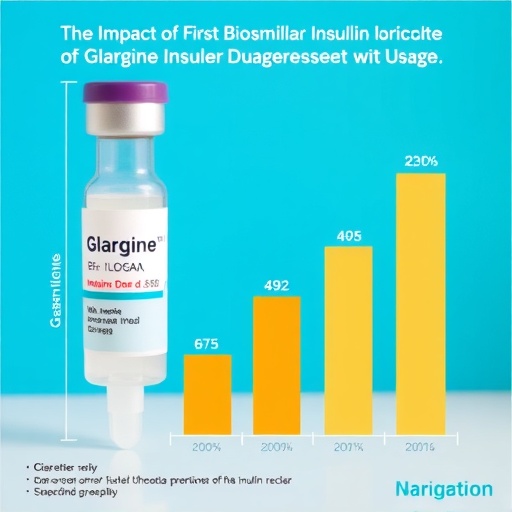In the evolving landscape of diabetes treatment, the introduction of biosimilar insulin has marked a significant milestone, particularly with the advent of insulin glargine biosimilars. A recent study by Watanabe et al. delves into this phenomenon, focusing on the utilization and spending patterns associated with insulin glargine before and after the introduction of its first biosimilar. This exploration offers vital insights into both the economic and clinical implications of biosimilar therapies, illuminating their potential to reshape diabetes care.
Biosimilars, which are biologic medical products highly similar to already approved reference items, have been heralded as a cost-effective alternative to expensive biologics. The first biosimilar insulin glargine was launched in the United States, raising questions about how its availability affects the market dynamics of insulin usage. The motivations behind this study are crucial as they aim to assess real-world impacts rather than controlled clinical trial outcomes. Therefore, by employing extensive data analysis, researchers can gauge how such a significant change in the marketplace influences patient care.
The study meticulously tracks insulin glargine usage, highlighting the spending trends associated with both the reference product and its biosimilar counterpart. Prior to the biosimilar’s launch, insulin glargine spending had seen a steady increase, largely driven by rising prices attributed to manufacturers’ pricing strategies and market demand. The entry of the biosimilar is particularly critical as it aims to curb costs that have burdened both patients and healthcare systems.
A significant element of the Watanabe study is the evaluation of prescription patterns. The analysis reveals a notable shift in physician prescribing behaviors post-biosimilar introduction. Healthcare providers are increasingly aware of biosimilars’ effectiveness, encouraging a departure from the traditional reference product towards these potentially more affordable alternatives. This paradigm shift not only benefits financial aspects but also represents an informed decision-making process founded on the betterment of patient outcomes.
The researchers employed a real-world data approach, utilizing claims data from large insurance providers to conduct their analysis. This method offers a robust reflection of actual patient experiences compared to randomized controlled trials, which may not always represent broader population dynamics. By mining through this data, the study captures a variety of demographic factors that influence insulin glargine usage, thereby comprehensively examining how the biosimilar’s launch aligns with patient needs and healthcare provider practices.
Understanding patient adherence to treatment regimens is another critical component of the study. Formulary changes occurring due to the introduction of biosimilars may influence how patients manage their diabetes. With lower out-of-pocket costs potentially associated with biosimilar options, adherence rates may improve, thereby enhancing overall diabetes management and patient satisfaction. The research emphasizes the importance of affordability and access to medications, which could ultimately lead to better health outcomes.
Moreover, the findings of the study offer a glimpse into the broader implications for health insurance models in the context of rising drug prices. As biosimilars continue to emerge, insurers may implement strategies to encourage their utilization, such as tiered formularies and patient education initiatives. This shift may not only help control escalating costs but may also result in a more equitable distribution of diabetes management resources among different patient populations.
The study also identifies potential barriers to the uptake of biosimilars among healthcare providers and patients alike. Despite the potential for cost savings, there may still be hesitancy rooted in misconceptions about the safety and efficacy of biosimilars. The research underscores the need for further educational efforts aimed at demystifying biosimilars for both prescribers and patients. Ensuring that accurate information is disseminated can mitigate fears and promote more widespread acceptance.
As the biosimilar market continues to expand, further studies like the one conducted by Watanabe et al. will be crucial in evaluating long-term impacts. The dynamics of insulin purchasing and utilization patterns are ever-evolving, and ongoing real-world data analyses will be necessary to keep pace with these shifts. Such insights will guide not only healthcare providers and patients but also policymakers who are tasked with ensuring sustainable healthcare access.
In conclusion, the implications of the study by Watanabe and colleagues are vast, as they echo a broader trend toward the adoption of biosimilars in various therapeutic areas. Understanding insulin glargine utilization and spending patterns in the wake of the biosimilar’s introduction underscores the importance of ongoing research in shaping informed healthcare decisions. The increasing availability of such alternatives not only provides hope for improved patient outcomes but also sparks a potential transformation in diabetes management.
As the healthcare landscape continues to evolve, the release of further biosimilars presents an opportunity to analyze the shifts in prescriber behavior, patient adherence, and overall healthcare spending. The transition towards biosimilars could signal a new era, where patients have improved access to affordable medications and hence better overall health outcomes become a reality.
With the study’s findings set to inform future practices and policies, the need for vigilance in monitoring the biosimilar landscape remains paramount. Diabetes care can benefit immensely from the validation provided by such thoughtful investigations, ultimately leading to a brighter and more equitable future for all those affected by this chronic illness.
Subject of Research: Utilization and spending patterns associated with insulin glargine and its biosimilar.
Article Title: Insulin Glargine Utilization and Spending Before and After the First Biosimilar Insulin Glargine: A Real-World Data Study.
Article References:
Watanabe, J.H., Strand, M.W., Shen, W. et al. Insulin Glargine Utilization and Spending Before and After the First Biosimilar Insulin Glargine: A Real-World Data Study.
J GEN INTERN MED (2025). https://doi.org/10.1007/s11606-025-09917-5
Image Credits: AI Generated
DOI: https://doi.org/10.1007/s11606-025-09917-5
Keywords: Biosimilar Insulin, Insulin Glargine Utilization, Diabetes Management, Healthcare Spending, Real-World Data Study.
Tags: biologic medical products comparisonbiosimilar insulin glargine impactbiosimilar therapies in healthcarecost-effective diabetes therapiesdiabetes treatment advancementseconomic implications of biosimilarsinsulin glargine utilization analysisinsulin market dynamicspatient care in diabetes managementreal-world insulin usage trendsspending patterns in diabetes careWatanabe study on insulin glargine





